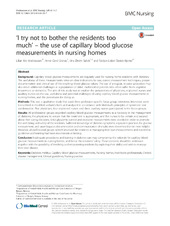| dc.contributor.author | Andreassen, Lillan Mo | en_US |
| dc.contributor.author | Granas, Anne G | en_US |
| dc.contributor.author | Sølvik, Una Ørvik | en_US |
| dc.contributor.author | Kjome, Reidun Lisbet Skeide | en_US |
| dc.date.accessioned | 2016-06-27T10:52:44Z | |
| dc.date.available | 2016-06-27T10:52:44Z | |
| dc.date.issued | 2016-02-04 | |
| dc.Published | BMC Nursing. 2016 Feb 04;15(1):7 | eng |
| dc.identifier.uri | https://hdl.handle.net/1956/12192 | |
| dc.description.abstract | Background Capillary blood glucose measurements are regularly used for nursing home residents with diabetes. The usefulness of these measurements relies on clear indications for use, correct measurement techniques, proper documentation and clinical use of the resulting blood glucose values. The use of a regular, invasive procedure may also entail additional challenges in a population of older, multimorbid patients who often suffer from cognitive impairment or dementia. The aim of this study was to explore the perspectives of physicians, registered nurses and auxiliary nurses on the use, usefulness and potential challenges of using capillary blood glucose measurements in nursing homes, and the procedures for doing so. Methods This was a qualitative study that used three profession-specific focus group interviews. Interviews were transcribed in modified verbatim form and analysed in accordance with Malterud’s principles of systematic text condensation. Five physicians, four registered nurses and three auxiliary nurses participated in the focus groups. Results All professional groups regarded capillary blood glucose measurements as a necessity in the management of diabetes, the physicians to ensure that the treatment is appropriate, and the nurses to be certain and assured about their caring decisions. Strict glycaemic control and excessive measurements were avoided in order to promote the well-being and safety of the residents. Sufficient knowledge of diabetes symptoms, equivalent practices for glucose measurement, and unambiguous documentation and communication of results were determined to be most helpful. However, all professional groups seldom involved the residents in managing their own measurements and stated that guidelines and training had been inconsistent or lacking. Conclusion Inadequate procedures and training in diabetes care may compromise the rationale for capillary blood glucose measurements in nursing homes, and hence the residents’ safety. These concerns should be addressed together with the possibility of involving and empowering residents by exploring their ability and wish to manage their own disease. | en_US |
| dc.language.iso | eng | eng |
| dc.publisher | BioMed Central | eng |
| dc.rights | Attribution CC BY 4.0 | eng |
| dc.rights.uri | http://creativecommons.org/licenses/by/4.0 | eng |
| dc.subject | Diabetes mellitus | eng |
| dc.subject | Capillary blood glucose measurements | eng |
| dc.subject | Nursing homes | eng |
| dc.subject | Healthcare professionals | eng |
| dc.subject | Chronic disease management | eng |
| dc.subject | Clinical guidelines | eng |
| dc.subject | Nursing practice | eng |
| dc.title | ‘I try not to bother the residents too much’ – the use of capillary blood glucose measurements in nursing homes | en_US |
| dc.type | Peer reviewed | |
| dc.type | Journal article | |
| dc.date.updated | 2016-02-24T12:58:16Z | |
| dc.description.version | publishedVersion | en_US |
| dc.rights.holder | Copyright Andreassen et al. 2016 | |
| dc.identifier.doi | https://doi.org/10.1186/s12912-016-0129-7 | |
| dc.subject.nsi | VDP::Medisinske Fag: 700 | en_US |

